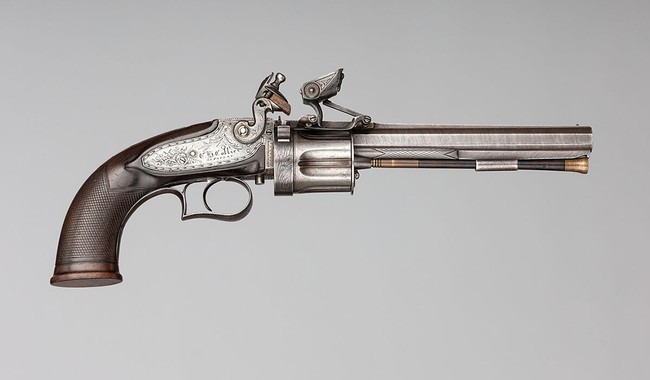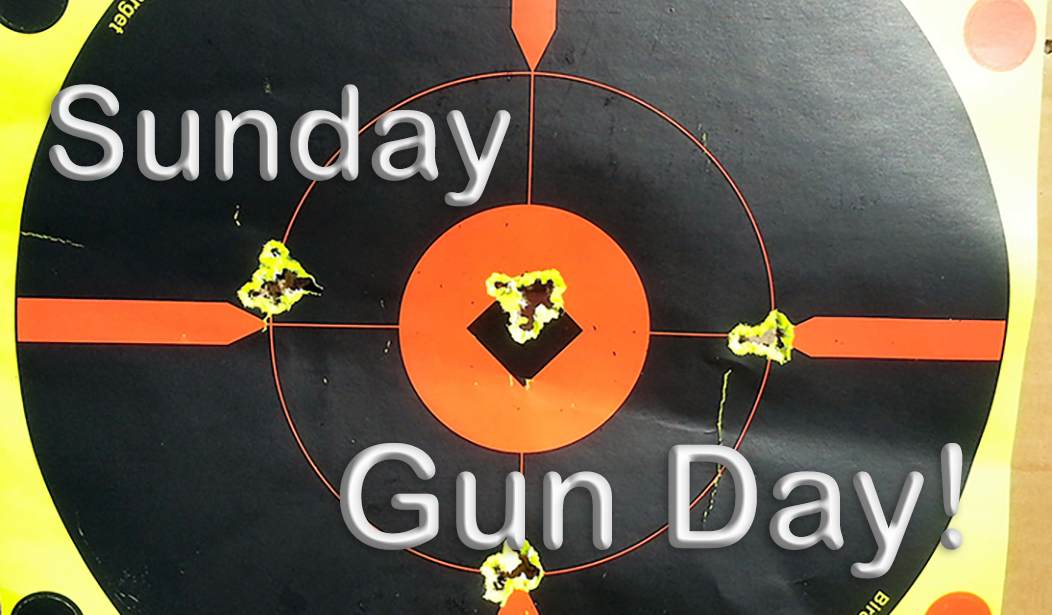
…And Colonel Colt Made Them All Equal
It’s well known that Sam Colt is the father of the modern sixgun – or seven, eight, or ninegun, depending on which model of revolver you’re talking about. But Sam did set the modern form of the percussion-fired revolver: A fixed single barrel, a rotating cylinder holding the ammo, an action in which cocking the hammer rotated the cylinder to bring a live round under said hammer, ready to be fired by (just ask Alec Baldwin) pulling the trigger.
But Sam Colt didn’t develop his six-shooters in a vacuum, and there is at least one gun predating the percussion-cap era that is at least suspected to have been an influence on the young Colt.
The Brig Corvo
In 1830, after a pyrotechnics display set up by the young Colt went badly wrong and started a fire at his boarding school, Colt’s father, Christopher Colt, “persuaded” his 16-year-old son to go to sea on the battered old brigantine “Corvo.” While on a voyage to Calcutta, the young Sam Colt carved a model of what he may have thought of as a pepperbox pistol, but that differed in many ways from a pepperbox – it had a fixed single barrel and a pawl attached to the trigger to rotate the cylinder containing the loads. It was the recent advent of the percussion cap, which replaced the flintlock mechanism, that made Colt’s design practical, but rumor has it that Colt found inspiration in another quarter, as on the brig “Corvo” was another rotating-cylinder piece: A flintlock Collier revolver.
Yes. A flintlock revolver.
The Collier
In 1818, one Elisha Collier, an American engineer living in London, happened to come across a design for a repeating flintlock pistol dreamed up by another American who was also living in London. The other American ex-pat was Captain Artemas Wheeler of Concord, Massachusetts, who had come up with a remarkable design: A five-shot flintlock revolver with a cylinder that had to be rotated by hand between shots. Once fired, the shooter not only had to rotate the cylinder but also to manually cock the hammer (actually called a “cock” in flintlock guns) before taking another shot, and if the reservoir of priming powder on the frizzen was empty, the results could be embarrassing. However, this made this a pretty effective repeating sidearm with the flintlock ignition system. That required a bit of doing, but there’s an old saying that “If it’s stupid but works, it’s not stupid,” and Wheeler’s design struck some chords.

Wheeler had patented the device in the United States. Collier studied the design and patented it in Britain, with some improvements, and the production of Collier rifles, in both pistol and rifle forms, began. The guns were manufactured by John Evans & Son of London starting in 1819, and in these days of the Napoleonic Wars, found a small but dedicated market among military officers who saw the advantage of a repeating sidearm. The use of a single barrel reduced the weight of the gun over pepperbox designs, which were then starting to show up and made reloading easier, but the flintlock mechanism was still susceptible to moisture and required frequent changes of flint for reliability.
See Related: Napoleon's Pistols Command a Bonaparte-esque Price at Auction
In the end, only about 225 Collier revolvers in both handgun and long gun forms were made. That’s not a great number; these were expensive, hand-made carriage trade items and well beyond the financial reach of hoi polloi on either side of the Atlantic.
The early nineteenth century was a boom time in firearms design. Not only was the modern form of the revolver being set, but around 1820, the advent of the percussion cap changed everything. The finicky flintlock design was rapidly replaced by the more reliable, cleaner percussion cap system, doing away with the need for a priming pan full of loose powder and a cock holding a chunk of brittle flint, and making the revolving action very much more practical – and affordable. Sam Colt was quick to capitalize on this, as were two chaps from Norwich, Connecticut, named Horace Smith and Dan Wesson, among others.
There were other attempts at building a flintlock repeater, although none achieved even the modest success of the Collier. One of the more notable was the Kalthoff repeater, a sort of a lever gun wherein a fore-and-aft movement of the trigger guard served to charge and prime the piece; different versions of the Kalthoff guns, which were made from the 1630s until the 1690s by a variety of gunsmiths, had capacities of up to 30 shots, making them the first repeater with a “high-capacity” magazine, which would draw a suspicious eye from gun-grabbers today – and negates the idea that “assault weapon” magazine capacities are something of a new idea.
See Related: Surgeon General Bows to Gun-Grabbing Biden, Declares 'Firearm Violence' a 'Public Health Crisis'
But the Collier was unique; not only was it one of the last attempts at a flintlock repeater, it was one of the first to set the basic pattern of the modern revolver.
And Then This Happened
Only a few years later, the advent of fulminate of mercury and the percussion cap had indeed changed everything. Sam Colt would, in the cabin of the brig “Corvo,” supposedly examine a Collier revolver and apply its operation to a wooden prototype that would eventually lead to the 1836 Paterson revolver and, after that, the great historic run of Colt sixguns. But it all started in the early days of the 19th century, with Captain Artemas Wheeler and Elisha Collier.
(EDITOR'S NOTE: Normally, this "Sunday Gun Day" column would be behind the RedState paywall. This week, it’s not, in honor of our 20th Anniversary. To support our independent journalism amidst the efforts of government and Big Tech censors to silence us, we invite you to become a VIP member. By using the special discount code of “RS20” you'll get 60% off. Thank you for your ongoing readership and support of RedState.)














Join the conversation as a VIP Member